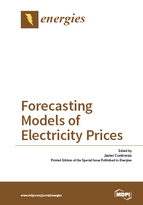Forecasting Models of Electricity Prices
A special issue of Energies (ISSN 1996-1073).
Deadline for manuscript submissions: closed (31 August 2016) | Viewed by 66013
Special Issue Editor
Interests: power system operation; power system planning; distributed generation; distribution planning; renewable energy sources; smart grid; distribution reliability; demand-side management; energy storage; electric vehicles; optimization
Special Issues, Collections and Topics in MDPI journals
Special Issue Information
Dear Colleagues,
The electric power industry has been in transition, from a centralized, towards a deregulated, production scheme since the early 1980s. Previous centralized schemes were based on electricity tariffs that were paid by the customers as a function of the aggregate cost of production. In the new unbundled scheme, price forecasting has become an important tool for electric companies and customers to decide on their production offers and demand bids and for regulators to characterize the degree of competition of the market.
Electricity prices have unique features that are not observed in other markets, such as weekly and daily seasonalities, on-peak vs. off-peak hours, price spikes, etc. The fact that electricity is not easily storable and the requirement of meeting the demand at all times makes the development of forecasting techniques a challenging issue.
This Special Issue will include the most important forecasting techniques applied to the forecasting of electricity prices, such as:
- Statistical time series models: auto regression models, GARCH,
- Fourier and wavelet transform models
- Fundamental or structural econometric models
- Regime-switching models: Markov, jump diffusion,
- Multi-agent and game theoretic equilibrium models: Nash-Cournot, supply function equilibrium, agent-based methods, etc.
- Artificial intelligence models: Neural networks, fuzzy logic, support vector machines, etc.
In this Special Issue, we invite submissions exploring cutting-edge research and recent advances in the field of electricity price forecasting.
Prof. Javier Contreras
Guest Editor
Manuscript Submission Information
Manuscripts should be submitted online at www.mdpi.com by registering and logging in to this website. Once you are registered, click here to go to the submission form. Manuscripts can be submitted until the deadline. All submissions that pass pre-check are peer-reviewed. Accepted papers will be published continuously in the journal (as soon as accepted) and will be listed together on the special issue website. Research articles, review articles as well as short communications are invited. For planned papers, a title and short abstract (about 100 words) can be sent to the Editorial Office for announcement on this website.
Submitted manuscripts should not have been published previously, nor be under consideration for publication elsewhere (except conference proceedings papers). All manuscripts are thoroughly refereed through a single-blind peer-review process. A guide for authors and other relevant information for submission of manuscripts is available on the Instructions for Authors page. Energies is an international peer-reviewed open access semimonthly journal published by MDPI.
Please visit the Instructions for Authors page before submitting a manuscript. The Article Processing Charge (APC) for publication in this open access journal is 2600 CHF (Swiss Francs). Submitted papers should be well formatted and use good English. Authors may use MDPI's English editing service prior to publication or during author revisions.
Keywords
- Electricity price forecasting
- Time series
- Transform models
- Fundamental models
- Regime-switching
- Multi-agent
- Market equilibrium
- Artificial intelligence






